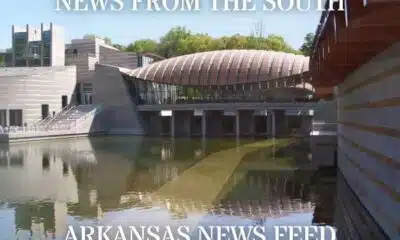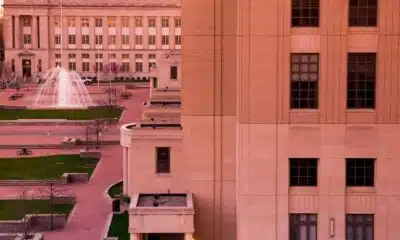News from the South - Texas News Feed
A Venezuelan Was Detained as a “Documented” Gang Member by ICE, Which Refused to Provide Proof
Jesús Escalona Mújicas, a 48-year-old Venezuelan asylum-seeker, says he was en route to work at a construction site on the morning of April 9 when a group of immigration agents and state and federal police officers stopped his car in a rural area near Bryan—an event that led to him being arrested, publicly accused of membership in a transnational prison gang, and deported.
According to a Texas Department of Public Safety (DPS) arrest report, the officers were with DPS, the Federal Bureau of Investigation (FBI), and Immigration and Customs Enforcement agents (ICE). Escalona Mújicas told the Texas Observer that one of the agents said he had an outstanding deportation order, a claim he disputed by saying he had temporary permission to be here and a pending asylum case. (ICE, via a spokesperson, maintains that he “had no immigration benefits that prevented his arrest and removal.”)
But the details of any immigration case didn’t seem to matter. In an interview, Escalona Mújicas said he was told he’d been targeted under an 18th-century law being revived by the Trump Administration—the Alien Enemies Act. Agents then took him to a gas station parking lot where he was accused of belonging to Tren de Aragua, a Venezuelan gang designated by the United States as a foreign terrorist organization.
That same day, ICE issued a press release announcing Escalona Mújicas’s arrest and calling him a “documented Tren de Aragua gang member,” accompanied by a photo of him wearing a camouflage John Deere sweatshirt, silver handcuffs, and a wide-eyed expression.
But reporting by the Observer casts doubt on ICE’s claim. Days after the arrest, Oswaldo Azuaje, a friend, helped start a social media campaign in Venezuela in an attempt to clear Escalona Mújica’s name: “He has never been imprisoned or had a criminal record. His life has always been marked by hard work and integrity. He has no connection to the Tren de Aragua case,” Azuaje wrote. In mid-July, the Observer reached Escalona Mújicas in Venezuela by phone, and he recalled being shocked by the allegation. “Me? A gang member? I’m a person with good conduct,” he said. A father of two teen girls, he said he’d never heard of Tren de Aragua until after his arrival in Texas.
Before emigrating, Escalona Mújicas worked for the same employer, Empresas Polar, a Venezuelan Pepsi affiliate, for nearly two decades. He has no criminal history or record of gang activity in Texas and only traffic tickets in Venezuela, according to a search of U.S. and Venezuelan public records and interviews. In an interview, another Venezuelan friend and former neighbor, María Iriza Mendoza, rejected the gang accusation, calling him a “very hard-working man.” Back in Venezuela, she said, “He didn’t even have vices.”
In March, President Donald Trump signed a proclamation declaring that Tren de Aragua was invading the United States and invoking the Alien Enemies Act of 1798, a war-time law that his administration is using to fast-track expatriations—without due process—of immigrants accused of belonging to criminal gangs. Venezuelans, who arrived in large numbers in recent years and in many cases received Biden-era temporary protections, have been singled out as a target for Trump’s aggressively anti-immigrant policies.
The same month, the administration flew more than 200 Venezuelans to a megaprison in El Salvador—the majority of whom had no criminal records. One man was misidentified, perhaps due to a mixup with another person whose photo appeared in a Texas gang database. U.S. authorities have used tattoos and clothing items to determine Tren de Aragua membership, although experts told the Observer that these can’t be used as reliable indicators. Escalona Mújicas has no tattoos.
Police body camera footage obtained by the Texas Observer only shows a portion of the traffic stop and Escalona Mújicas’ arrest.
But it’s clear from the recordings that the ambush was planned. In his recording, DPS officer Erik Zani said: “He’s on his way. We’re probably 300 yards behind him. He’s just driving real slow, like he did the other day. He’s still coming down to approach that four-way stop. He should be getting there any minute now.” Seconds later, sirens go off.
By Escalona Mújicas’ account, before he opened his car door at the traffic stop, an agent told him “the President does not want to see Haitians, Nicaraguans, Cubans, or Venezuelans here.” The Observer could not obtain footage of that conversation.
At least five police cars and seven officers surrounded Escalona Mújicas, according to footage recorded by three DPS officers. A minute after sirens sounded, Escalona Mújicas was pressed against his car with his hands behind his back and illuminated only by red and blue police emergency lights, video shows.
One of the arresting officers was DPS Special Agent Garrett Burkhart, who had been specifically requested to assist FBI and ICE “with the apprehension of a TREN DE ARAGUA gang member,” according to a DPS arrest report. That report wrongly identified Escalona Mujica’s nationality–identifying him as “an alien of El Salvadorian origin without legal status in the United States.”
Escalona Mújicas is Venezuelan rather than Salvadoran, according to public records, a press release from ICE, and Escalona Mújicas himself.
Burkhart watched as other agents detained Escalona Mújicas, videos show.
“You have an order for arrest with the immigration,” another agent told Escalona Mújicas in Spanish. “Do you understand? Do you understand? What is your complete name?”
Burkhart then walks away as other officers handcuffed him. “Cameras off!” another yelled, and the recording ends.
Agents then escorted Escalona Mújicas to a gas station, where they interviewed him and accused him of having gang ties, he said. (In response to a records request, DPS said that although an agent was present in the interview, they did not have a recording.)
The Observer shared the details of Escalona Mújicas’ case, including the DPS arrest report, with experts who said they doubted ICE and DPS had targeted the right individual. “To be totally frank, it sounds like they fucked up,” said Mike LaSusa, deputy director of content and an investigative researcher at InSight Crime, a think tank and newsroom that has researched and reported on Tren de Aragua. LaSusa noted specifically that DPS misidentified Escalona Mújicas as Salvadoran. “This isn’t an indication of strong intelligence work, if they can’t get the guy’s nationality right.”
The DPS report itself also states that Escalona Mújicas did not appear in TxGANG, Texas’ problem-plagued gang database: “While sufficient criteria was not available to document ESCALONA MUJICAS as a gang member in TXGANG, SA Burkhart was advised that the United States Attaché in Guatemala had documented ESCALONA MUJICAS as a TREN DE ARAGUA gang member.”
Escalona Mújicas told the Observer he passed through Guatemala briefly en route from Venezuela to Texas. While on a bus migrating through the country, he explained, U.S. and Guatemalan authorities stopped him and a few others, plucking them out of a group of passengers at a checkpoint in Coatepeque, a town roughly 20 miles from the Mexican border. (Escalona Mújicas did not recall which agency the U.S. authorities worked with; he said they wore uniforms with U.S. flags, and appeared to be soldiers.)
The other men selected from the group, Escalona Mújicas noted, had tattoos of trains, crowns, or Air Jordan sneakers.
Authorities took his ID and passport information, collected his fingerprints, and photographed him and his Air Jordans—which they claimed were a symbol of gang membership, he said.
Kristin Etter, director of policy and legal services at the Texas Immigration Law Council, expressed surprise at DPS’s use of overseas intelligence from a U.S. attaché—a federal official who’s assigned to a foreign diplomatic mission or embassy—to try to designate someone in the United States as a gang member. She was also alarmed by the incorrect nationality in the DPS report. “It appears that almost everything about this report is false. So, who knows whether that was intentionally so, or just due to sloppy police work,” Etter said.
The FBI and DPS did not respond to Observer requests for comment. When asked about proof of Escalona Mújicas’ gang affiliation, ICE spokesperson Tim Oberle provided a statement “Attributable to a Senior DHS Official” that said Escalona Mújicas had entered the country illegally and had an active order of removal. (The Observer was unable to verify Escalona Mújicas’ claims to the contrary; U.S. immigration court records are not public, and he said he left those documents in the car at the time of his arrest.)
The ICE statement continued: “We are confident in our law enforcement’s intelligence, and we aren’t going to share intelligence reports and undermine national security every time a gang member denies he is one. That would be insane.”
During his month in ICE detention, loved ones feared he’d be sent to CECOT, the megaprison in El Salvador. “My mom, my dad, everyone was going around scared. My brother, my sister, my nephew, you have no idea,” he said.
Escalona Mújicas was deported to Venezuela on May 1, according to ICE. In an interview, he recalled sharing a plane with 300 others, all in shackles. It had been almost three years since he’d been laid off from his job as a forklift operator at Empresas Polar, the Pepsi affiliate, leading him on his journey through the treacherous Darien Gap, across Central America, and eventually to Texas.
When he spoke to the Observer in mid-July, he said he was preparing to emigrate again: this time, to Spain, a country that has fewer immigration restrictions for Venezuelans. In mid-August, Escalona Mújicas spoke to the Observer again by phone—this time from Madrid, where he began a new construction gig this week.
Even though ICE has refused to provide information to substantiate its claims, experts including Etter from the Texas Immigration Law Council said the consequences of the press release labelling him as a gang member could last.
“That could be an issue that could follow him, really, the rest of his life.”
Valentina Lares and Laura Weffer of the Organized Crime and Corruption Reporting Project contributed to this report.
The post A Venezuelan Was Detained as a “Documented” Gang Member by ICE, Which Refused to Provide Proof appeared first on www.texasobserver.org
Note: The following A.I. based commentary is not part of the original article, reproduced above, but is offered in the hopes that it will promote greater media literacy and critical thinking, by making any potential bias more visible to the reader –Staff Editor.
Political Bias Rating: Center-Left
This content critically examines immigration enforcement actions under the Trump administration, highlighting potential errors, misidentifications, and harsh treatment of asylum seekers. It emphasizes the human impact of aggressive immigration policies and questions the reliability and fairness of law enforcement claims. The tone and focus align with a Center-Left perspective that is generally sympathetic to immigrant rights and skeptical of strict immigration enforcement practices, while relying on investigative reporting and expert opinions rather than overt ideological language.
News from the South - Texas News Feed
Liberty Hill ISD adopts 4-day week amid budget cuts
SUMMARY: Liberty Hill Independent School District plans a Tax Ratification Election this November to raise $11 million for student programs, safety, and teacher retention after cutting $6.3 million and 70 positions last year. To support teachers amid budget cuts, the district will implement a four-day school week during parts of the year starting mid-September. Interim Superintendent Travis Motal highlighted the district’s rapid growth of about 1,000 students annually, requiring close coordination with developers and officials to prepare infrastructure and schools. The district is also interviewing candidates for a new superintendent, with a decision expected in January.
Read the full article
The post Liberty Hill ISD adopts 4-day week amid budget cuts appeared first on www.kxan.com
News from the South - Texas News Feed
James Dobson, Focus on the Family founder and key leader on the Christian right, dies at 89
SUMMARY: James Dobson, founder of Focus on the Family and influential conservative Christian leader, died at 89. Born in 1936, he launched a radio show and ministry promoting traditional Christian parenting and conservative values, significantly impacting American politics from the 1980s onward. Dobson advised five presidents, supported strict discipline like spanking, opposed abortion and LGBTQ+ rights, and promoted conversion therapy. His organization shaped the evangelical hub in Colorado Springs and influenced conservative policymaking, including support for the Dobbs decision overturning Roe v. Wade. Dobson remained a powerful voice until his death, leaving a complex legacy blending religious advocacy and political activism.
The post James Dobson, Focus on the Family founder and key leader on the Christian right, dies at 89 appeared first on www.kxan.com
News from the South - Texas News Feed
What mid-decade redistricting would mean for Texans
“Lawmakers are debating GOP congressional maps. What does redistricting mean for Texans?” was first published by The Texas Tribune, a nonprofit, nonpartisan media organization that informs Texans — and engages with them — about public policy, politics, government and statewide issues.
Sign up for The Brief, The Texas Tribune’s daily newsletter that keeps readers up to speed on the most essential Texas news.
Texas’ mid-decade redistricting effort has sparked a national fight between Republicans and Democrats over congressional maps ahead of the 2026 midterm elections. But what does redistricting mean for Texas beyond political calculations?
Some experts said that by prioritizing partisan advantages, Texas Republicans’ proposed map — which could secure them around five more GOP seats — threatens the representation of Texans across the state by lumping together communities with different populations and geographies.
And Texas is extremely diverse. Texans in cities have different needs than those living in the state’s rural areas; Gulf residents and people living more inland have different priorities; Texans in El Paso and those living near the wildfire-prone pine forests of Bastrop may want different things from their leaders.
When a representative’s district covers multiple communities with wide-ranging needs, it’s difficult for elected officials to focus on the issues that matter the most to each one of them, said Álvaro Corral, an assistant professor of political science at the University of Texas Rio Grande Valley.
“All of a sudden, you … don’t really have a recognizable community,” Corral said. “I think that’s … the keyword — this … recognizability of a coherent, cogent community that has shared interests … starts to wither away.”
That can make it harder for voters in Texas cities, suburbs, rural regions and different geographic areas to have their voices heard, experts said.
“If you’ve got a constituency that’s too wide and too different, then it makes it nearly impossible for that member to truly reflect those interests,” said Brandon Rottinghaus, a political science professor at the University of Houston.
What is gerrymandering?
Gerrymandering happens when the boundaries of a district for an elected representative are manipulated to favor a particular party or group. It’s typically done by “packing” a group of voters into as few districts as possible, or by “cracking” a group by spreading voters thinly across several districts to limit their ability to elect representatives of their choice.
States are in charge of redrawing district boundaries for their representatives in Congress and their state lawmakers, but there are some federal guidelines set by the U.S. Constitution, federal courts and the Voting Rights Act meant to ensure equal representation.
Congressional districts must generally have similar populations. In Texas, each of the state’s 38 congressional districts has to include about 767,000 people.
The Voting Rights Act in some cases has protected the creation of “minority-majority districts” — districts where most residents belong to a racial group that has been historically underrepresented, such as Black or Latino voters — to avoid diluting their vote. However, the U.S. Supreme Court has recently indicated it plans to review the constitutionality of some minority-majority districts created under the Voting Rights Act, leaving the future of these protections in question.
Texas’ maps, including the existing congressional maps drawn in 2021, have faced lawsuits over Voting Rights Act violations, and Texas Democrats have argued the new proposed maps would further hurt Black and Latino voters in regions such as Houston and the Rio Grande Valley.
For example, under the proposed maps, the 34th Congressional District, a Latino and Rio Grande Valley district currently held by U.S. Rep. Vicente Gonzalez, a Democrat, would be reshaped to take part of the 27th Congressional District, a whiter and coastal district represented by U.S. Rep. Michael Cloud, a Republican.
State Rep. Matt Shaheen of Plano, has argued online that the proposed maps would give Latinos, who have become less decisively Democratic in parts of Texas like the Rio Grande Valley, more power to shape elections.
But experts said scrambling to redraw congressional districts ahead of midterm elections could hurt voters by undercutting their voice, causing confusion or creating distrust in the political system.
“If you give voters a reason to think that the political system is rigged and that it works against them, and that it’s political elites that are essentially crafting the outcome before votes are cast, well, then, you know, guess what? You get really low voter turnout,” he said. “And Texas has some of the lowest voter turnout of all 50 states.”
Urban and rural differences
In the past, congressional districts could often be clearly recognized as either rural or urban districts with different needs, Corral said. These days, however, some Texas congressional districts stretch hundreds of miles and can include cities, suburbs and rural regions, he said.
For example, the 9th Congressional District includes a slice of Houston’s urban core and fans out to Harris County’s rural eastern edge. The district is currently represented by U.S. Rep. Al Green and voted 27.2% for President Donald Trump last year. Under the Texas House’s proposed map, support for Trump would increase to almost 60%, according to an analysis by The Texas Tribune.
Under the new maps proposed by Republicans, some districts that once primarily represented cities and suburbs that often swing Democratic would be broken up and stitched to large rural areas, effectively handing rural GOP primary voters more control over who represents some of the state’s largest cities. Democrats and community groups argue that the mid-decade redistricting would also rob constituents of representatives with experience navigating Congress to improve their parts of the state.
Lumping together different types of communities can also complicate a lawmaker’s ability to address local needs, Rottinghaus said. For example, schools and health care providers face different challenges in urban environments and rural areas. While people in cities may have more access to resources and demand for them, residents in rural areas may have to travel longer distances for specialized services.
Meanwhile, suburbs have to grapple with meeting the needs of growing development and diversifying communities.
Respecting existing community markers such as city lines can help produce more neutral maps, even in populous cities that may require more than one district, said Jonathan Cervas, an assistant teaching professor at Carnegie Mellon who was appointed by a New York state court to redraw New York’s congressional map after it was found to be partisan.
“If you’re drawing a neutral map, you might try to keep large parts of Austin into a single district, with the idea that Austin has its own distinct features, its own communities and that by keeping them together, you enhance representation,” he said.
Instead, Texas’ maps tend to jam together portions of different cities, Cervas said. For example, in the proposed maps the 10th Congressional District stretches more than 200 miles, encompassing more than a dozen mostly rural counties, including Trinity and San Jacinto, while cutting through a slice of Austin’s downtown area. Other portions of Travis County would be attached to the 11th District, which stretches all the way to Ector County near the Texas-New Mexico border, a span of more than 330 miles.
Coastal and inland differences
Differing natural environments can also pose challenges for representatives, who may have to respond to natural disasters or environmental concerns within their districts.
While the Texas Coast faces the threat of flooding and property damage from hurricanes and storm surges, more inland parts of Texas, like pine-forested Bastrop, often need more water amid droughts and wildfires. And yet, the two regions are currently paired together in the 27th Congressional District, represented by U.S. Rep. Michael Cloud.
Communities face specific local challenges even along the Texas Coast, from concerns about environmental damage amid SpaceX operations near Brownsville to fishermen’s worries about increasingly closed oyster harvest areas concentrated near Corpus Christi and Houston.
“The practical policy needs are very different all across Texas,” Rottinghaus said. “The wide swath of geography and diversity of people means that you’ve got so many different, often competing interests that make it hard for members to have to take a clear stand.”
Border differences
Texans along the U.S.-Mexico border also face unique issues, including concerns about the impact of tariffs on international trade and local jobs, the Trump administration’s stance on immigration, and border wall construction near homes and wildlife centers.
Daniel Diaz, a member of the Rio Grande Valley grassroots organization La Unión del Pueblo Entero, said this is why it’s concerning that Texas’ maps have stuck border communities into districts that include areas that don’t share their experiences or priorities.
Mayors along the border in predominantly Latino cities like McAllen have pushed back against federal Immigration and Customs Enforcement raids, Diaz said. In contrast, local officials in Goliad County — which is closer to San Antonio than it is to the border and would shift from the 27th District to the border-anchored 15th District under the redrawn map — have been keen on cooperating with ICE, Diaz said.
“So it’s very different,” he said. “It’s such a weird combination of folks being put into this district.”
Adding drainage infrastructure to unincorporated border communities, or colonias, to prevent flooding on roads and homes is also a key concern that Rio Grande Valley residents like Edith Cuevas worry will get lost amid redistricting.
“For those concerns to be shown through people’s vote is a really big difference in our everyday lives,” said Cuevas, a co-founder of the Building Leaders and Organizing Our Movement (BLOOM) RGV, which focuses on youth civic engagement and voter registration.
What does fair redistricting look like?
With so many different communities across Texas — and so many possible ways to draw boundaries between them — Cervas said there’s no one way to perfectly draw the state’s 38 congressional districts. Even attempting to draw more uniform districts could be flawed because “communities don’t always line up perfectly in squares and grids,” he said.
But partisan gerrymandering hurts representation, Cervas argued, while striving to create politically neutral districts built around a community’s needs and composition tends to create more electoral competition. The latter gives voters more of a say over who represents them and their concerns, he said.
“Democracy relies on people having the ability to make choices about who represents them,” he said. “And when we gerrymander, we lose that ability, and it doesn’t matter whether it’s Democrats or Republicans or African Americans or Hispanics or even if it’s white voters, it doesn’t matter who is the one on the losing end. It’s bad for democracy.”
Princeton University’s Gerrymandering Project rates states’ political maps based on the degree of partisan gerrymandering in each one of them. Samuel Wang, director of the Gerrymandering Project, said his team reviews past voting patterns and runs computer simulations of what fairer maps could look like, allowing them to gauge “when a map has favored party beyond any other consideration.”
Wang’s team concluded that Texas’ current congressional maps were unfairly drawn and rated them with an F. Wang said the proposed maps appeared to be even worse.
Several states that have been found to have less partisan gerrymandering, such as Colorado and Michigan, redrew their maps through citizen commissions that had extensive public input and discussion, Wang said. In other cases, there was more bipartisan governance, such as in Minnesota, or state courts intervened to address partisan gerrymandering.
Unlike many of the states where citizen initiatives created independent redistricting commissions, Texas does not allow citizens to vote directly on redistricting reforms. That means any new maps or redistricting policies would have to come from the Republican-controlled Legislature, which also leaves the minority party with little leverage to influence how the districts are drawn.
So in states like Texas, Wang said redistricting can be “a weak point that can be exploited” and that “gives us the appearance of democracy without having actual democracy.”
Disclosure: University of Texas – Rio Grande Valley has been financial supporters of The Texas Tribune, a nonprofit, nonpartisan news organization that is funded in part by donations from members, foundations and corporate sponsors. Financial supporters play no role in the Tribune’s journalism. Find a complete list of them here.
More all-star speakers confirmed for The Texas Tribune Festival, Nov. 13–15! This year’s lineup just got even more exciting with the addition of State Rep. Caroline Fairly, R-Amarillo; former United States Attorney General Eric Holder; Abby Phillip, anchor of “CNN NewsNight”; Aaron Reitz, 2026 Republican candidate for Texas Attorney General; and State Rep. James Talarico, D-Austin. Get your tickets today!
TribFest 2025 is presented by JPMorganChase.
This article originally appeared in The Texas Tribune at https://www.texastribune.org/2025/08/21/texas-redistricting-congressional-map-texans/.
The Texas Tribune is a member-supported, nonpartisan newsroom informing and engaging Texans on state politics and policy. Learn more at texastribune.org.
The post What mid-decade redistricting would mean for Texans appeared first on feeds.texastribune.org
Note: The following A.I. based commentary is not part of the original article, reproduced above, but is offered in the hopes that it will promote greater media literacy and critical thinking, by making any potential bias more visible to the reader –Staff Editor.
Political Bias Rating: Center-Left
This content presents a critical view of Republican-led redistricting efforts in Texas, highlighting concerns about partisan gerrymandering and its impact on fair representation, particularly for minority and urban communities. It emphasizes expert opinions that favor politically neutral or bipartisan approaches to redistricting and underscores the challenges posed by maps drawn to benefit one party. While it includes perspectives from Republicans, the overall framing leans toward advocating for fairer, less partisan maps and points out the disadvantages of current Republican proposals, reflecting a center-left bias. The tone remains largely factual and analytical without overt partisan rhetoric.
-
News from the South - Texas News Feed6 days ago
Kratom poisoning calls climb in Texas
-
News from the South - Texas News Feed4 days ago
New Texas laws go into effect as school year starts
-
News from the South - Tennessee News Feed6 days ago
GRAPHIC VIDEO WARNING: Man shot several times at point-blank range outside Memphis convenience store
-
News from the South - Florida News Feed4 days ago
Floridians lose tens of millions to romance scams
-
News from the South - Kentucky News Feed6 days ago
Unsealed warrant reveals IRS claims of millions in unreported sales at Central Kentucky restaurants
-
Mississippi Today6 days ago
‘Get a life,’ Sen. Roger Wicker says of constituents
-
News from the South - Kentucky News Feed7 days ago
Woman charged in 2024 drowning death of Logan County toddler appears in court
-
News from the South - Virginia News Feed7 days ago
In Chesterfield, Earle-Sears slams Spanberger, revives Youngkin’s winning campaign slogans















































